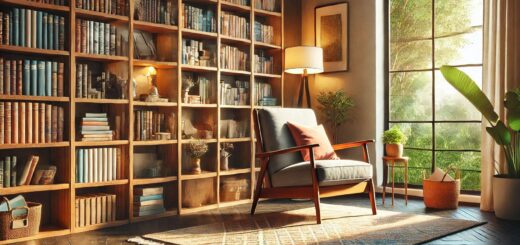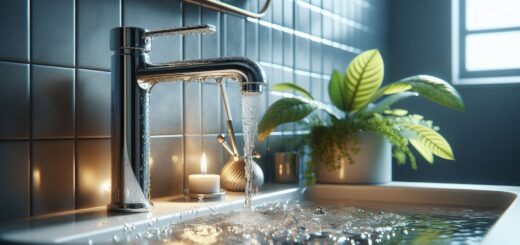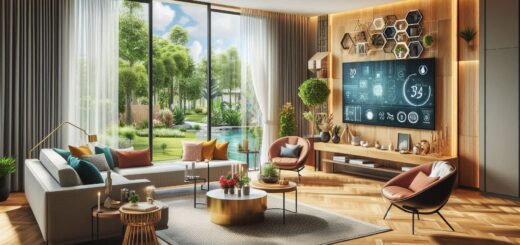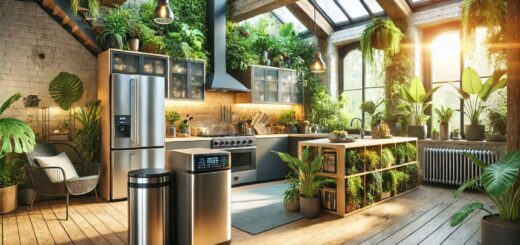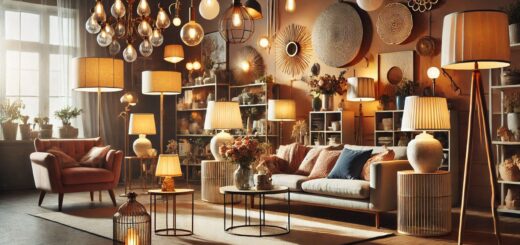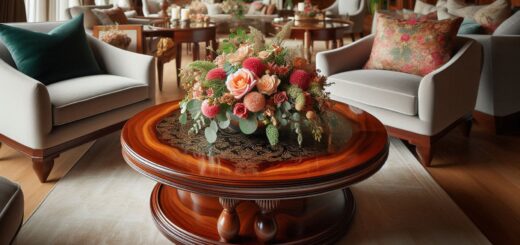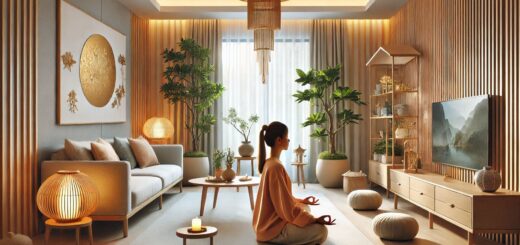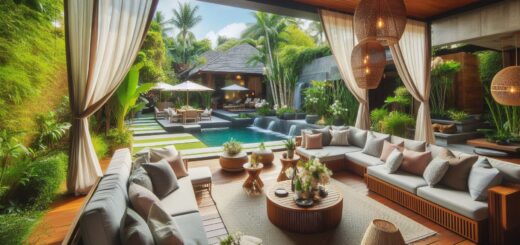Top 10 Ways to Style Your Coffee Table with Ease
A coffee table is more than just a functional piece of furniture—it serves as the focal point of your living room, reflecting your personality and tying together the room’s aesthetic. With the right styling, your coffee table can enhance your space’s appeal while remaining practical and inviting. In this guide, we’ll explore the top 10 ways to style your coffee table effortlessly, offering both style and functionality.
Table of Contents
Why Coffee Table Styling Matters
A well-styled coffee table creates balance, warmth, and interest in the living room. It often serves as the center of attention, especially in a seating area. The right combination of accessories can elevate the entire space, making it feel more inviting and cohesive. When styled thoughtfully, a coffee table becomes an extension of your personal style and provides a subtle way to tie together the various elements in your room, from the color palette to furniture styles.
The Role of Coffee Tables in Home Decor
Coffee tables provide a place to display decor, store items, and even host functional elements such as remote controls or coasters. But beyond practicality, they offer a unique opportunity for creative expression. Whether placed at the center of your living room or tucked into a cozy corner, your coffee table bridges the gap between seating arrangements, balancing form and function. Proper styling transforms the table from an ordinary fixture into a statement piece, highlighting your design aesthetic and drawing attention to your home’s overall vibe.
How Coffee Table Styling Reflects Personal Style
Your coffee table decor serves as an extension of your personality. The items you choose to decorate with—be it books, plants, art pieces, or personal keepsakes—can express your unique taste and interests. Whether you prefer a minimalist, modern approach or a more eclectic, bohemian look, the styling of your coffee table offers a chance to showcase your creativity. A well-curated coffee table can tell a story about your preferences, hobbies, and life experiences, making your living room feel distinctly yours.
10 Simple and Stylish Ways to Decorate Your Coffee Table
Styling your coffee table doesn’t have to be complicated. By incorporating these ten strategies, you can create a chic and welcoming centerpiece that adds style and sophistication to your space.
1. Use a Tray as a Base
Benefits of Using Trays
Trays are more than just functional; they serve as an essential design element when styling your coffee table. By acting as a contained space, trays offer a way to organize your decor, ensuring that items are grouped together and not scattered across the table. This prevents the table from appearing chaotic and helps maintain a sense of harmony in the space. Additionally, trays allow you to easily change the look of your coffee table without having to completely overhaul the entire setup. Whether you’re updating for the season or simply looking for a fresh aesthetic, swapping out items on a tray is a simple and effective way to refresh the space.
Tray Material and Size Considerations
When selecting a tray, the material and size are key factors to consider for both function and visual harmony. The material of the tray should align with the overall style of your living room. For instance:
- Wood: Adds warmth and a rustic or classic feel, ideal for traditional or farmhouse-inspired spaces.
- Metal: Offers a sleek, modern look, especially in matte black, gold, or silver, fitting contemporary or industrial settings.
- Acrylic: Known for its clean, minimalist aesthetic, an acrylic tray works well in modern and eclectic spaces, offering transparency that lets the items on it take center stage.
- Rattan: Brings a natural, earthy vibe that works wonderfully in coastal, bohemian, or tropical environments.
When it comes to size, the tray should be proportionate to the size of your coffee table. A tray that is too small may look insignificant, while one that’s too large can overpower the table and make the space feel cramped. As a general rule, a tray should leave a few inches of space on all sides, allowing the table to feel balanced and open. For round tables, opt for a circular tray to complement the shape, while rectangular or square trays work well on longer, rectangular tables.
How to Layer Items in a Tray
Layering items in a tray is an art, requiring a balance of height, texture, and interest to create a visually pleasing display. The idea is to arrange items in a way that feels curated yet not overly structured. Here’s how to do it:
- Start with a Base: Begin with a few foundational pieces that will anchor your tray. A stack of books can serve as the perfect base, providing height and a solid foundation for other objects. Use books that reflect your style or personality, whether they’re art books, travel guides, or fashion magazines.
- Add Height: Height creates visual interest and prevents the tray from feeling flat. A tall vase with flowers or branches can add drama and texture. Consider using sculptural objects, like a decorative sculpture or a unique artifact, to introduce varying heights and shapes.
- Play with Texture: Texture is crucial to make the display feel rich and layered. Mix soft textures, like a woven coaster or a fabric napkin, with harder elements, such as ceramic or metal objects. A combination of matte and glossy surfaces will also create depth in the arrangement.
- Add Greenery: Incorporating plants, whether real or faux, adds life and freshness to the space. A small potted plant or a sprig of greenery in a vase can brighten up the tray, providing a natural contrast to the more structured elements like books or trays. Succulents are a popular choice for their compact size and ease of care.
- Use Candles or Decorative Objects: Candles, whether lit or not, add warmth and coziness to the tray. Their soft, flickering light creates an inviting atmosphere. Decorative objects, such as small bowls, trinkets, or even a delicate clock, can also serve as focal points that draw attention and add personality.
- Balance and Variation: The key to layering is balance. Use odd numbers for grouping items (such as three candles or two plants with one sculpture) to create a more natural, visually appealing arrangement. Vary the height and size of objects to avoid uniformity. The goal is to create an arrangement where your eye moves easily across the tray, taking in different textures, shapes, and details.
By thoughtfully combining these elements, you can create a tray display that feels cohesive, stylish, and effortlessly inviting. The tray not only organizes your items but also acts as a mini vignette that reflects your taste and adds a touch of personality to your coffee table.
2. Incorporate Books
Choosing the Right Coffee Table Books
Coffee table books are one of the most personal and visually striking elements you can incorporate into your coffee table decor. These books not only offer a functional role—providing reading material for guests—but they also serve as stylish decorative accents that reflect your personal taste. When selecting coffee table books, focus on those with eye-catching covers and content that aligns with your interests. The book’s cover design should be aesthetically pleasing and complement the overall color scheme of your room.
Consider books on topics that resonate with you and spark conversation. Some ideas include:
- Fashion: Fashion coffee table books often feature iconic designers, striking photography, and elegant designs, making them a perfect choice for those passionate about style.
- Photography: Beautifully illustrated books showcasing photography, whether historical, modern, or nature-focused, offer a stunning visual experience and allow guests to admire artwork or landscapes while browsing.
- Architecture: Books focusing on architectural designs, home interiors, or cityscapes can add sophistication and create an intellectual vibe, especially in contemporary or modern spaces.
- Travel: Travel books provide an escape and allow you to showcase images of far-flung destinations, inspiring wanderlust and sparking engaging conversations about different cultures and experiences.
Selecting books with themes that mirror your personality or passions gives the coffee table a personal touch, making it more than just a decor piece, but a conversation starter as well.
Arranging Books for Maximum Visual Appeal
Once you’ve selected the books, it’s time to arrange them in a way that enhances their visual impact. The key to making books a standout feature is in the arrangement. The most effective way to style books is to stack them in small groups, typically of two or three books per stack. The largest book should go on the bottom, providing a stable base, while smaller books on top will create an interesting layered effect. This method introduces height variation and a sense of order, helping to avoid a flat, disorganized look.
Consider organizing the stacks either vertically or horizontally, depending on the shape and size of your coffee table. Horizontal stacks work well for longer tables, while vertical stacks can be ideal for smaller tables. You can also mix up the orientation for added dimension. Stacks of books can serve as the foundation for showcasing decorative items like small vases, candles, or sculptural objects, turning your books into functional platforms that elevate other elements of your display. This layering effect can make your coffee table feel curated and thoughtfully arranged.
Balancing Books with Other Decorative Items
While books are essential in coffee table styling, it’s important not to let them dominate the entire table. You want the books to be a part of a well-balanced design, not the sole focus. Leave breathing room around the books to allow space for other decorative objects to shine and create a harmonious layout.
To enhance the visual appeal of your coffee table and add dimension, pair your books with other decor elements:
- Small Plants: Adding a tiny potted plant or succulent next to a stack of books brings a natural, fresh touch. The organic shape of the plant contrasts nicely with the structured lines of the books, adding visual interest and a pop of color.
- Sculptural Objects: A sculptural piece, whether abstract or a detailed artifact, can add a sense of artistry and make the coffee table feel more like an intentional vignette. A well-placed object can break up the visual block of books and provide a focal point.
- Candles: Strategically placing a candle on top of a stack of books or nearby can create a warm, inviting ambiance. The flickering light of a candle also adds an element of texture and movement to the arrangement.
By balancing books with these other items, you create a layered and dynamic display that feels curated but not overcrowded. Remember, the goal is to create a cohesive look where each piece, whether a book or decorative object, plays a role without overwhelming the space.
3. Add Greenery or Floral Arrangements
Importance of Natural Elements in Coffee Table Styling
Incorporating natural elements like plants and flowers into your coffee table arrangement is one of the most effective ways to infuse your space with life and vibrancy. Greenery brings a fresh, calming presence to your living room, softening the sharp lines of furniture and providing a contrast to the often rigid or polished textures of decorative objects and books. Natural elements help balance the more man-made or architectural aspects of your space, grounding the decor and creating a harmonious environment. Whether you’re using fresh flowers or low-maintenance houseplants, greenery can transform the ambiance of the room, making it feel more inviting, alive, and full of energy.
In addition to adding aesthetic appeal, plants and flowers have the ability to uplift moods and promote well-being. The mere presence of greenery can reduce stress and contribute to a more serene atmosphere, making your living room feel like a peaceful retreat.
Types of Plants and Flowers Suitable for Coffee Tables
When selecting plants or flowers for your coffee table, it’s important to choose varieties that thrive in small spaces and are easy to care for. Here are some options that work particularly well for coffee table styling:
- Succulents: Succulents are compact, low-maintenance, and visually striking, making them perfect for coffee tables. Their unique shapes and vibrant green hues bring texture and interest to the space. Options like Echeveria, Aloe Vera, or Jade Plants are great choices.
- Orchids: Orchids add a touch of elegance and sophistication to your table with their delicate, colorful blooms. They are perfect for a modern or minimalist setting and come in various colors to suit your decor.
- Snake Plants (Sansevieria): Known for their tall, upright leaves and architectural shape, snake plants are not only beautiful but incredibly low-maintenance. They thrive in low light and require minimal watering, making them ideal for a coffee table.
- Fresh Flowers: For a burst of seasonal beauty, fresh flowers like lilies, tulips, or peonies add charm and fragrance to the space. These flowers bring a sense of seasonality to the room and can be updated regularly to reflect different times of year.
- Artificial Flowers: If you’re not home often or simply prefer low-maintenance options, high-quality artificial flowers can offer the same beauty without the upkeep. Faux flowers like silk orchids or hydrangeas look realistic and provide consistent color and texture year-round.
For those who prefer simplicity and convenience, many artificial plants are available that replicate real greenery with incredible realism, ensuring the space always looks fresh and vibrant.
Arranging Greenery for Aesthetic Impact
Once you’ve selected your plants or flowers, arranging them thoughtfully is essential to maximizing their aesthetic impact. The goal is to incorporate the greenery in a way that complements the rest of your decor while adding dimension and balance to the coffee table.
- Choose Decorative Pots or Vases: Elevate the look of your plants by placing them in decorative pots or vases that suit your overall style. A matte ceramic pot, a shiny metallic vase, or a woven basket can add texture and color to your arrangement. The vessel should either blend seamlessly with your other decor or provide an interesting contrast to create visual interest.
- Group Multiple Plants: If you have several plants, grouping them together in varying sizes creates a layered effect that adds depth to the table. For example, placing a tall plant, like a snake plant, next to a shorter succulent or small orchid creates a dynamic display. Varying the height, shape, and color of your plants ensures the arrangement doesn’t feel flat or monotonous.
- Single Statement Piece: Alternatively, if you prefer a minimalist approach, consider using a single statement piece as the focal point. A large, lush plant in the center of the coffee table, like a fiddle leaf fig or a striking orchid arrangement, can become the centerpiece that draws attention and elevates the overall look of the space.
- Consider the Color Palette: Pay attention to how the plant’s leaves, flowers, or foliage will interact with the color scheme of your coffee table and the rest of the room. For instance, dark green plants like snake plants or ivy add a sense of sophistication to neutral-colored tables, while vibrant flowers like yellow tulips or pink peonies can add a cheerful pop of color to a more subdued setting.
- Vary the Textures: Texture plays an important role in adding visual interest to your coffee table. Mix plants with different textures, such as smooth-leaved succulents and feathery, soft-edged fern leaves, to create a tactile contrast that enhances the overall feel of the arrangement.
By thoughtfully incorporating plants and floral arrangements into your coffee table styling, you bring a natural element into your living space that feels fresh and inviting. Whether you opt for a vibrant burst of seasonal flowers or elegant, low-maintenance plants, greenery adds both beauty and tranquility to your home.
4. Feature Candles or Lanterns
Benefits of Ambient Lighting
Candles and lanterns are more than just decorative pieces—they play a crucial role in creating the right ambiance for your living space. The soft, flickering glow of candles adds a sense of warmth and tranquility that no other light source can replicate. This gentle light creates a welcoming, cozy atmosphere, making your coffee table not just a functional piece of furniture but a central feature that enhances the overall mood of the room.
Especially in the evening or during intimate gatherings, candles offer a romantic, relaxing, and soothing vibe. Their subtle illumination also provides a feeling of calm and comfort, perfect for unwinding after a long day or setting the tone for a gathering. Lanterns, with their slightly larger structure and ability to hold multiple candles, can also add a rustic or vintage charm to the table, creating a more dramatic lighting effect.
Choosing the Right Size and Shape
When selecting candles for your coffee table, the size and shape of the candles should vary to create visual interest. A diverse collection of candles will add texture, depth, and balance to the arrangement. Here’s how to choose the right ones for your space:
- Varying Heights: Tall pillar candles bring a sense of grandeur and elegance, especially when grouped with smaller candles. For instance, a tall pillar candle in the center, flanked by smaller votives or tea lights, adds dimension to your coffee table. Taller candles draw the eye upward, while shorter candles fill in around the edges.
- Small Tea Lights and Votives: Small candles, such as tea lights or votive candles, offer a soft, subtle light that adds a delicate touch to your arrangement. These smaller candles work well when placed in clusters, giving off a gentle glow without overwhelming the table.
- Candle Shapes: Candles come in a wide variety of shapes—round, square, tapered, or unscented decorative forms. Opt for a variety of shapes to create an intriguing mix, or choose one specific shape to maintain a more cohesive and streamlined look. Unconventional shapes, like geometric candle holders, can bring a modern or artistic flair to your arrangement.
- Scented Candles: If you’re looking to engage the senses beyond just sight, scented candles can bring another layer of luxury and personal touch to your coffee table. Choose scents that complement the room’s mood—fresh, floral fragrances for a calming feel or warm, spiced scents like cinnamon or vanilla for a cozy, intimate vibe.
Pairing Candles with Other Accessories
To maximize the visual impact of your candles, it’s important to pair them with other decor items on your coffee table. Rather than letting the candles stand alone, grouping them with complementary objects will elevate their presence without overwhelming the space. Here are a few ways to integrate candles seamlessly into your coffee table design:
- Decorative Trays: A decorative tray can provide a base for your candles, helping to group them together in a cohesive way. The tray could be made of metal, wood, or acrylic, depending on the tone of your space, and it will help contain the candles, making the arrangement look more intentional.
- Greenery: Candles pair beautifully with plants and flowers. You could place a few small candles next to a plant or succulent arrangement, creating a juxtaposition between the organic, natural elements and the soft glow of the candles. The candles and greenery together can evoke a peaceful, nature-inspired vibe.
- Sculptural Objects: Small sculptural items, like figurines, art objects, or unique decor pieces, can also be paired with candles to create a stylish balance. The candles enhance the tactile qualities of the sculptures, while the sculptures add dimension and intrigue to the overall setup.
- Mirrors and Reflective Surfaces: Using reflective surfaces like a mirrored tray or small mirror underneath or behind the candles can amplify their glow and create a striking visual effect. The reflection of the candlelight on the mirror will double the light, making the table appear even warmer and more inviting.
- Candle Holders: Consider investing in decorative candle holders that match your style, whether it’s minimalist, bohemian, or traditional. Candle holders come in a wide range of materials—glass, brass, wood, or ceramic—and can contribute to the aesthetic value of your table. Choose holders that are unique yet complement the rest of your decor.
In arranging the candles and their accessories, ensure that the candles don’t dominate the table. The goal is for the candles to enhance the overall coffee table arrangement without overwhelming it. The soft, warm light of the candles should draw attention in a subtle, inviting way, allowing other decor elements, such as books, plants, or sculptures, to shine alongside them.
By thoughtfully incorporating candles or lanterns into your coffee table styling, you bring a sense of warmth, elegance, and comfort to the space, making it more inviting and enjoyable for anyone who spends time in the room.
5. Showcase Unique Decorative Objects
Importance of Personal Touches in Styling
Decorative objects are an essential way to infuse your personality into your coffee table arrangement. These items give your space a sense of individuality and help create a coffee table setup that feels uniquely yours. Whether it’s a vintage sculpture from a flea market, an artisan-made vase that tells a story, or a collection of mementos from your travels, these objects make your coffee table more than just a functional piece of furniture—they transform it into a personal expression of your style and interests.
Having personal touches scattered across the table, such as a family heirloom, a favorite book, or a keepsake from a special moment, can also serve as conversation starters. These unique items create a welcoming atmosphere and allow guests to connect with you through your decor. Instead of relying solely on generic decor, these distinctive objects make your home feel lived-in and inviting.
Popular Decorative Objects for Coffee Tables
There are countless decorative objects that can enhance the style and personality of your coffee table. Here are some popular choices:
- Glass Cloches: Glass cloches, typically used to display plants or small trinkets, add a touch of vintage charm to your table. The transparency of the glass helps them fit into nearly any setting, while their unique form brings a sense of curiosity and elegance.
- Marble Spheres: Marble spheres or other polished stone items can provide a sophisticated, refined look. Their smooth texture and understated design make them ideal for modern or classic decor, and their solid structure adds weight and balance to a table arrangement.
- Wooden Sculptures: Hand-carved or artistically designed wooden sculptures bring warmth and texture to a coffee table. Wood adds an organic, natural element to the space, offering a pleasing contrast to the harder, glossier surfaces often found in modern living rooms.
- Vintage Trinkets: Small vintage trinkets or collectibles can inject character and charm into your coffee table design. Whether it’s an antique box, a decorative glass bottle, or a retro piece, these items have history and can add depth and richness to your decor.
- Handmade or One-of-a-Kind Items: Incorporating handmade or artisanal items, such as a hand-painted dish or a crafted ceramic bowl, can provide a personalized and authentic touch. These pieces often tell a story, making them perfect for showcasing individuality and adding a sense of craftsmanship to your table.
- Metallic Accents: Items made from brass, gold, or silver can introduce a luxurious, polished look to the table. A small metallic tray, a brass figurine, or a gold-leafed object can provide a glamorous accent, especially in modern or eclectic spaces.
Arranging Objects for Cohesion
The way you arrange your decorative objects is crucial for creating a balanced, cohesive look. A coffee table arrangement with too many objects can feel cluttered, while too few may seem sparse or unfinished. Here are tips on how to arrange decorative objects effectively:
- Use Odd Numbers: When grouping decorative objects, arrange them in odd numbers, such as three or five items. Odd-numbered groupings tend to feel more natural and visually appealing. They create a dynamic, organic flow that’s more engaging to the eye than even-numbered arrangements, which can appear more rigid or symmetrical.
- Vary the Textures and Materials: To keep your coffee table visually engaging, combine a variety of textures, shapes, and materials. Mixing smooth glass or ceramic with rougher wooden or metal objects adds contrast, making each item stand out. This contrast between materials keeps the arrangement fresh and interesting. For example, a polished marble sphere can be paired with a rough-textured ceramic vase for an appealing contrast.
- Mix Different Shapes: Incorporate a variety of shapes, including round, square, and geometric forms, to add depth to your design. A combination of angular and rounded items will create a well-rounded aesthetic and prevent the setup from feeling too rigid or predictable. For example, you might arrange a round glass cloche with a square sculptural piece to introduce variety.
- Create a Focal Point: When arranging your objects, place one item in the center as a focal point, with surrounding pieces arranged in a balanced manner around it. The focal point can be something eye-catching like a vintage sculpture or a decorative box, with smaller pieces around it providing complementary visual interest.
- Leave Breathing Room: While it’s tempting to fill every available space, it’s important to leave negative space around your objects. This will help the individual pieces breathe and prevent the arrangement from feeling overcrowded. The goal is for each item to have its own space and presence on the table, contributing to a sense of harmony and intentionality.
By thoughtfully selecting and arranging unique decorative objects on your coffee table, you can create an arrangement that feels cohesive, personal, and engaging. Whether you prefer modern minimalism, vintage charm, or eclectic styles, these objects not only enhance your space visually but also provide a glimpse into your personality and taste.
6. Mix Textures and Materials
Importance of Diversity in Textures
Incorporating a variety of textures and materials into your coffee table styling is essential for creating a dynamic, visually appealing display. Mixing contrasting elements adds depth and interest, ensuring the arrangement doesn’t feel flat or one-dimensional. By pairing different textures, you evoke a tactile richness that draws the eye and engages the senses. Textural diversity helps to soften harsh lines or sleek surfaces and can also evoke a sense of comfort, making the space feel more inviting.
For example, combining the smooth, reflective surface of glass with the rough, earthy feel of natural stone creates a pleasing contrast that adds sophistication to the table. Similarly, metal and wood complement each other by balancing the cold, shiny quality of metal with the warmth and organic texture of wood. The combination of contrasting materials can set a tone of modern elegance, rustic charm, or eclectic style, depending on your preferences.
Examples of Textures to Incorporate
Here are some examples of materials and textures that can be used to create a rich, layered coffee table display:
- Glass: Glass is a versatile material that adds elegance and transparency to the table. Whether you use a glass vase, a cloche, or a glass sculpture, this material offers a sense of lightness and sophistication. The transparency of glass allows other elements, like books or decorative objects, to be visible through the material, enhancing the layering effect.
- Wood: Wood adds warmth and a natural element to your coffee table. The texture of wood can range from smooth and polished to rough and rustic. Consider a wooden tray, carved sculpture, or wooden bowl to bring a grounded, organic feel to the arrangement.
- Ceramic: Ceramic items, such as vases or sculptures, offer a tactile quality that contrasts beautifully with more polished materials. Ceramic can range from smooth and shiny to matte and textured, allowing you to choose pieces that fit your desired style. A ceramic vase paired with other natural elements, like a woven basket or stone object, can create an intriguing contrast.
- Metal: Metals like brass, gold, silver, or copper can add a touch of luxury and modernity. Whether it’s a metallic candle holder, decorative tray, or metallic sculpture, this material catches the light beautifully and provides a sleek contrast to softer materials like wood or fabric.
- Textiles (Linen, Faux Fur, Velvet): Soft materials like linen, faux fur, and velvet add a tactile, comforting feel to your coffee table. Incorporating a linen table runner or a velvet cushion enhances the visual appeal and adds a cozy texture to the space. These softer elements create a balance with harder materials like metal or stone, making the space feel more inviting and comfortable.
- Stone: Natural stones like marble, granite, or onyx can add a sense of luxury and timeless beauty. Whether it’s a stone tray, a marble sculpture, or a stone bowl, the texture of these materials brings a grounded, earthy element to the display while providing contrast to softer textures like textiles or glass.
- Woven Materials: Woven baskets, rattan trays, or jute coasters introduce a rustic, handcrafted touch to your table. These natural materials have a rougher texture that pairs beautifully with smoother, more polished items like glass or metal, creating a visually balanced and cohesive look.
Combining Materials for Visual Balance
While it’s important to mix different textures and materials, the key is to create a balanced and harmonious arrangement. Too many contrasting textures can overwhelm the space, so it’s essential to find a way to blend materials that complement each other.
Here are some tips for achieving visual balance:
- Hard and Soft: A successful mix often involves pairing hard materials (like glass, metal, or stone) with soft materials (like fabric, ceramics, or woven materials). The balance between the two will keep the display grounded and interesting. For instance, pairing a smooth, glass vase with a soft, woven basket creates a tactile balance that is both elegant and cozy.
- Shiny and Matte: Mixing shiny materials (like metal or glass) with matte finishes (like wood or ceramic) can create a refined, multi-layered look. The contrast between the reflective quality of shiny materials and the more subdued appearance of matte surfaces adds depth and complexity to your arrangement.
- Light and Dark: Play with the contrast between light and dark materials to create a sense of depth. For example, pairing a light-colored linen tray with a dark marble sculpture creates an eye-catching contrast that’s not too harsh but still adds visual impact.
- Textures that Compliment: Avoid mixing textures that are too similar, as this can create a monotonous look. Instead, aim for variety. A soft velvet cushion placed next to a textured ceramic bowl offers a pleasant tactile contrast, while natural wood and metal accents bring warmth and shine to the table.
By thoughtfully combining different textures and materials on your coffee table, you can create an arrangement that feels dynamic and visually stimulating. The variety of textures will add richness and complexity to the space, while the careful balancing of contrasting elements will keep the display from feeling too chaotic or overwhelming. The result is a sophisticated, inviting, and engaging coffee table that reflects your personal style.
7. Create Layers with Heights
Why Height Variations Add Depth
Incorporating height variations is essential for creating a dynamic, visually engaging coffee table arrangement. By elevating some items while keeping others lower to the table, you introduce a sense of depth and dimension that makes the display feel more layered and intricate. Without varying heights, a coffee table can appear flat or one-dimensional, which might detract from the overall visual appeal of the space.
Height variations help prevent the arrangement from feeling static, ensuring that the table remains interesting and inviting to look at from multiple angles. They guide the eye across the surface, creating a sense of movement and flow. Tall objects in the back or center provide a sense of prominence, while smaller items around them give balance and help fill in the spaces.
Tools for Elevating Coffee Table Decor
There are several tools and techniques you can use to introduce height into your coffee table styling, ensuring that every item has its moment in the spotlight while maintaining a sense of balance:
- Coffee Table Books: Books are one of the most versatile tools for creating height on a coffee table. By stacking books in a creative way, you can elevate smaller decor items or create a visually appealing base for a centerpiece. A stack of books with a striking cover or theme can act as a foundation for a vase, sculpture, or decorative object, adding a layer of dimension.
- Decorative Stands or Risers: Decorative stands, risers, or pedestals are perfect for elevating smaller items, like a decorative bowl, candle holder, or sculpture. These can be found in various materials like wood, metal, or marble, each adding its unique texture and style. A small brass stand can raise a delicate porcelain vase, allowing it to stand out against other, flatter decor.
- Tiered Trays: A tiered tray allows you to display decor on different levels, stacking smaller objects at the bottom and taller or more prominent items on the upper tiers. Tiered trays can be both functional and decorative, adding a vertical element to your table while organizing smaller items in an aesthetically pleasing way.
- Trays with Raised Edges: Trays with slightly raised edges provide a subtle elevation that separates the items within it from the rest of the table. These trays are perfect for containing a collection of objects and ensuring that items are not lost in the mix.
- Sculptural Stands: For a more artistic approach, consider using sculptural stands or abstract pedestals to lift certain decor items. These can be particularly effective when displaying a statement piece, like a modern sculpture or artwork, which would otherwise be lost on a flat surface.
Arranging Items with Height Variation
To make the most of height variation, it’s important to arrange items thoughtfully, ensuring that the taller elements don’t overwhelm the table or block the view of smaller objects. Here’s how you can arrange items for maximum visual appeal:
- Position Taller Items at the Back or Center: Place taller items—such as a large vase, tall sculpture, or statement plant—toward the back of the coffee table or at its center. These pieces naturally draw the eye, and by positioning them in these areas, you create a sense of balance. This placement allows the shorter pieces in front to remain visible while maintaining a focus on the taller items.
- Surround with Shorter Pieces: Place shorter objects around the taller items to fill in the space. These can include smaller decorative objects, candles, or potted plants. By varying the heights, you create a layered effect that guides the eye around the table, from the tallest objects to the shorter ones.
- Layer Objects in a Tiered Formation: Think of your coffee table as having several “tiers” or levels. You can create a tiered effect by placing taller pieces at the back and gradually decreasing the height of items toward the front of the table. This arrangement mimics the visual structure of a mountain range or landscape, creating an appealing flow and preventing the table from looking overly cluttered or flat.
- Use Items with Different Heights to Create Balance: To maintain visual balance, pair taller objects with medium-height pieces, and scatter shorter items to prevent any area of the table from feeling too sparse or overcrowded. For instance, a tall ceramic vase could be placed at the back, while a stack of coffee table books or a small sculpture could sit in front of it, balanced by a low-profile tray or a plant.
- Create Focal Points: Tall items can also be used to create focal points on your coffee table. By placing them slightly off-center or grouping them with other pieces of varying height, you draw attention to a specific area of the table, creating a visually dynamic center of interest.
- Use Negative Space Effectively: When arranging items with height variation, it’s important to leave negative space around the taller items to avoid overwhelming the space. This breathing room allows the individual items to shine without competing with one another. Proper use of negative space also ensures that the arrangement doesn’t feel cluttered.
By thoughtfully mixing and arranging objects of varying heights, you can create a coffee table display that feels both balanced and dynamic. Height variation adds depth, movement, and interest to the table, making the overall arrangement feel well-curated and visually stimulating. This approach not only highlights each individual piece but also contributes to an overall cohesive look that reflects your unique style.
8. Stick to a Color Palette
Importance of Consistency in Color
One of the most effective ways to ensure that your coffee table decor feels cohesive and well-organized is by sticking to a unified color palette. Consistency in color helps to create a visually appealing and harmonious look, preventing the arrangement from feeling chaotic or mismatched. A thoughtfully selected palette ties the coffee table decor into the overall room design, ensuring that the table’s aesthetic complements the rest of the space, rather than clashing with it.
Using a consistent color palette makes your coffee table look like a curated element of the room, rather than a standalone or disjointed setup. By repeating certain colors across various items—whether in the form of books, decor objects, or textiles—you establish a sense of balance that naturally leads the eye from one element to the next.
Choosing a Palette That Complements Your Space
When selecting a color palette for your coffee table, consider the overall aesthetic and tone of the room. The colors you choose for your table should either complement or subtly contrast with the room’s existing hues. Here are some considerations for choosing the right palette:
- Neutral Tones: Neutral colors like beige, gray, white, ivory, and taupe offer a timeless, classic appeal. These tones are perfect for a minimalist or modern style, as they provide a clean and calm base. Neutral colors allow for flexibility in incorporating other decorative items without overwhelming the space, and they work well in any room where you want a more understated, sophisticated look.
- Bold and Rich Colors: If you want to make a statement or add a pop of color, bold tones like deep blues, emerald greens, burgundy, or mustard yellow can create a dramatic focal point on your coffee table. These colors can add richness and depth to a room, especially if you have a more neutral or muted base in the decor. Pairing bold colors with neutral items helps to keep the table from feeling too overwhelming.
- Pastels and Soft Shades: For a more tranquil, fresh, or airy look, soft pastel shades like pale pink, mint green, or light lavender can introduce a sense of calm and serenity. These colors work beautifully in spaces designed for relaxation or lightness, such as bedrooms or living rooms with soft, natural lighting.
- Monochromatic Scheme: If you prefer a sleek, uniform look, you can choose different shades of one color to create a monochromatic palette. For example, using various tones of gray or blue can create a sense of unity while still allowing for texture variation. A monochromatic scheme works well in modern, contemporary, or Scandinavian-inspired rooms.
Incorporating Color Gradients
To add depth and complexity to your coffee table arrangement without overwhelming the eye, consider incorporating color gradients. Gradients allow you to seamlessly blend one color into another, creating a smooth transition of tones. This technique can make your coffee table display feel more dynamic and layered without being too bold.
For example:
- Start with Lighter Tones: Begin with light, airy colors like soft whites, creams, or pastels at the front or base of the table, and then gradually introduce darker tones like charcoal gray, navy, or forest green at the back. This creates a flow of color that guides the eye naturally across the surface of the table.
- Use Gradient Objects: You can incorporate items that feature color gradients themselves, such as a vase with an ombré effect, textiles with gradient hues, or ceramic pieces that transition in color. These objects act as a natural focal point and enhance the sense of depth and texture on the table.
- Pairing with Metallics: Combining metallics, such as gold, brass, or silver, with a gradient of matte colors can add a sense of luxury and contrast. For instance, a gold-trimmed vase placed against a gradient of deep blues and lighter teals can introduce elegance while maintaining color flow.
Gradients don’t have to be bold—subtle shifts between shades of the same color can add enough visual interest without overpowering the other elements on the table.
Final Tips for Color Harmony
- Limit the number of colors: While it can be tempting to use many colors, it’s often best to limit your palette to two or three main hues with a few accent colors. This will prevent your coffee table from feeling too busy.
- Consider color temperature: Choose colors that match the temperature of the room. If your room has warm tones (like beige or earthy hues), lean towards warm-colored accessories (such as copper, rust, or gold). For a cooler, more modern space, consider silver, navy, or cool grays.
- Test combinations: Before settling on a color scheme, place items in different combinations to see what works best in the context of the entire room. Step back and assess how the colors look together and with the room’s lighting, furniture, and wall color.
By sticking to a well-chosen color palette and using gradients, you can ensure that your coffee table decor blends seamlessly into your living space. The result will be a harmonious, visually striking table that enhances the room’s overall style.
9. Display Seasonal or Thematic Decor
Benefits of Rotating Coffee Table Decor
Rotating your coffee table decor to reflect the changing seasons is an excellent way to keep your space feeling fresh, dynamic, and personalized. By updating the items on your table with the seasons, you add a sense of timeliness and relevance, making your living room feel in tune with the world outside. A seasonal approach introduces new textures, colors, and objects into your home, creating a unique atmosphere that changes throughout the year.
Seasonal decor is also a way to keep things interesting. It adds variety without needing a full redesign. For example, swapping out fall decor for winter accents can refresh the look of your table without requiring you to purchase new furniture or large decor pieces. The rotation not only enhances the mood of the space but also allows you to celebrate different holidays, festivals, or themes throughout the year.
Ideas for Seasonal Arrangements
Each season has its own mood and palette, and you can easily translate this into your coffee table decor. Here are some ideas for seasonal arrangements:
- Spring:
- Colors: Pastel shades like soft pinks, lavenders, mint greens, and buttery yellows are perfect for spring. These colors evoke the freshness and renewal that the season represents.
- Decor Elements: Incorporate floral patterns, fresh blooms, and delicate vases. You could add small planters with succulents, or place a glass cloche over a blooming plant or delicate object. Easter-inspired decorations (such as eggs or bunnies) can also be a charming addition.
- Textures: Think light fabrics like linen, or use wicker trays and ceramic bowls to bring in a soft, natural vibe. Soft throws or cushions in pastel colors are also great additions.
- Summer:
- Colors: Bright and vibrant tones work well for summer, such as turquoise, coral, lemon yellow, or sunset orange. These colors can evoke the warmth and energy of the season.
- Decor Elements: Place seashells, beach-themed items like driftwood, or a small beach ball sculpture. Consider light floral arrangements or even citrus fruits in a bowl to keep the look fresh and summery.
- Textures: Incorporate light cotton fabrics, jute, or rattan. Glass jars or metallic accents in bright finishes can also reflect summer’s light, sunny atmosphere.
- Fall:
- Colors: Embrace earthy tones like burnt orange, deep reds, browns, gold, and rust to bring the cozy warmth of autumn indoors.
- Decor Elements: Use pumpkins, dried leaves, and pinecones. Candle holders or lanterns with warm candlelight can add a cozy vibe to the table. A small harvest display or autumn-inspired ceramics can be beautiful focal points.
- Textures: Think about rich textures like velvet, faux fur, or knitted throw blankets. Use wood or stone accents to reinforce the rustic, earthy vibe of fall.
- Winter:
- Colors: Winter decor often incorporates cool tones such as silver, ice blue, white, and deep jewel tones like emerald green or navy.
- Decor Elements: Consider metallic accents like gold or silver vases, sparkling ornaments, or holiday-themed decor such as snow globes or miniature trees. Candles are essential for creating a warm and intimate atmosphere during the colder months, especially when paired with faux fur throws or plush pillows.
- Textures: Soft, cozy textiles like faux fur or plush blankets are perfect for the winter months. Incorporate glass and metal to reflect winter’s clean, crisp feel.
How to Store and Reuse Themed Decorations
To keep things organized and make future seasonal transitions easier, consider storing your seasonal decor in labeled bins or boxes. Here’s how to make the most of your seasonal decor:
- Organized Storage: Label each bin or box by season or theme, and ensure that each item is stored properly to avoid damage. For example, fragile items like glass vases or decorative ceramics can be wrapped in tissue paper and stored in sturdy containers.
- Reuse and Repurpose: Many items can be repurposed across different seasons. For instance, you can swap out the flowers in vases—spring tulips can be replaced with fall branches or winter evergreens. Candle holders can be used year-round, simply by changing the candle scent or color to match the season.
- Minimal Effort for Maximum Impact: Keep some items that are neutral or timeless, like basic candles or decorative trays, to act as a base for each season. Simply change the other decor elements, such as floral arrangements, vases, or objects, to create a new seasonal feel without having to overhaul your entire table setup.
- Keep a Few Year-Round Pieces: Some decor items can seamlessly transition across seasons, such as metallic objects, geometric sculptures, or wooden trays. Having a few timeless pieces helps to minimize the amount of decoration you need to store and switch out.
By displaying seasonal or thematic decor on your coffee table, you can easily refresh your living room and celebrate the changes of the year. Whether you’re embracing the soft pastels of spring, the deep hues of fall, or the cozy ambiance of winter, rotating your decor will make your space feel continuously new and personalized.
10. Leave Room for Functionality
Balancing Style with Practicality
When styling your coffee table, it’s important to strike a balance between aesthetic appeal and practical functionality. While it’s tempting to fill your table with beautiful decor, you must also consider its everyday use. The coffee table should serve as a functional space for drinks, snacks, or remote controls while still looking stylish. A well-styled table should complement your lifestyle—whether it’s used for relaxing with a cup of coffee, gathering around with family, or entertaining guests.
Leaving enough space for essentials like coasters, remote controls, magazines, and drinks ensures that your coffee table remains practical for everyday use. At the same time, balancing this practicality with carefully curated decorative elements creates an inviting, stylish space that is both beautiful and functional.
Common Functional Items for Coffee Tables
Incorporating functional items into your coffee table decor is an excellent way to keep the space organized while maintaining its aesthetic appeal. Here are some common functional items that also serve as decor:
- Decorative Storage Boxes or Baskets: These are perfect for concealing clutter while adding texture and visual interest. Choose boxes or baskets that complement your room’s design. For example, a woven basket in a neutral tone can hide magazines, extra remotes, or chargers while still looking chic.
- Small Dishes for Keys or Remotes: A small, stylish dish or tray can be used to corral frequently used items like keys, remote controls, or even loose change. Opt for materials like ceramic, wood, or metal to match your overall decor style. This keeps the table tidy while maintaining an uncluttered look.
- Coasters: Coasters are a must-have for protecting your table from spills and stains. Select coasters that fit your room’s color scheme and style, whether they’re sleek and modern or textured and artisanal. A set of coasters can be neatly displayed on a tray, adding both function and style.
- Small Trays for Organization: A small tray placed on your coffee table can act as a catch-all for small items like pens, nail polish, or snacks. You can combine it with other functional decor pieces like a remote holder or phone stand to keep everything within reach but out of sight.
- Hidden Storage Compartments: Some coffee tables come with built-in storage options like hidden drawers or lift-top compartments. These features allow you to store items out of sight, keeping the table clean while still offering easy access to essentials. Consider investing in a table that combines both style and storage for a minimalist approach to clutter.
How to Keep the Table Clutter-Free
To maintain a clean and functional coffee table, follow these steps:
- Adopt a “Less is More” Philosophy: Regularly declutter your coffee table by removing items that no longer serve a functional or aesthetic purpose. Keep only the essentials and items that add beauty and purpose to the table. Excess items can quickly make a space feel crowded and overwhelming.
- Maintain a Routine of Regular Tidying: Make it a habit to clear off your coffee table at the end of the day or after an event. This helps keep the table organized and visually appealing. Store away items that are only temporarily needed, such as drinks or snacks, and return decorative items to their proper place.
- Utilize Functional Decor: Opt for functional decor that serves multiple purposes. For example, a decorative bowl can hold keys or jewelry, a stack of books can also function as a base for a lamp or plant, and trays can organize smaller objects while adding a stylish flair.
- Regularly Assess and Edit: Keep the table streamlined by reviewing its decor on a regular basis. Over time, you may find that certain items no longer align with your current style or needs. A quick edit to remove unnecessary objects will ensure the table remains inviting and useful.
By ensuring there is enough room for essential items, you can create a coffee table setup that is functional and beautiful. A clutter-free table promotes a serene and organized environment, while incorporating practical decor elements keeps the space inviting and useful for everyday living.
FAQs
What are the key elements of coffee table styling?
The key elements of coffee table styling include trays, books, greenery, decorative objects, and functional items. Balance and layering are essential to creating a cohesive and visually appealing setup.
How do I choose a theme for my coffee table decor?
Choosing a theme should be guided by your personal preferences, the room’s color palette, and the overall design style. You can opt for seasonal themes, color-based themes, or themes inspired by specific design trends.
What are some common mistakes to avoid when styling a coffee table?
Some common mistakes include overcrowding the table with too many items, using too many contrasting colors, and neglecting height variation. It’s essential to maintain a balance between style and functionality.
Can I style a coffee table without spending much money?
Absolutely! You don’t have to spend much to style your coffee table. Use items you already own, like books or plants. Thrift stores and DIY projects also offer affordable options for unique decor pieces.
How do I make my coffee table decor kid-friendly?
For a kid-friendly coffee table, avoid fragile items and opt for rounded objects. Use washable trays or baskets for storage, and choose spill-resistant materials for a more practical, safe design.
Are there any trends in coffee table styling for this year?
This year’s trends include natural materials like stone and wood, bold metallic accents, and vintage-inspired decor. Minimalism, sustainability, and sustainability are also strong trends.
Conclusion
Styling your coffee table is an opportunity to express your personal style while also maintaining the functionality of the space. By following these 10 tips, you can create a coffee table arrangement that enhances the beauty of your living room while being practical and inviting. Whether you prefer a minimalist look, a bold statement, or something in between, the key is to make it uniquely yours and create a space that feels like home.



